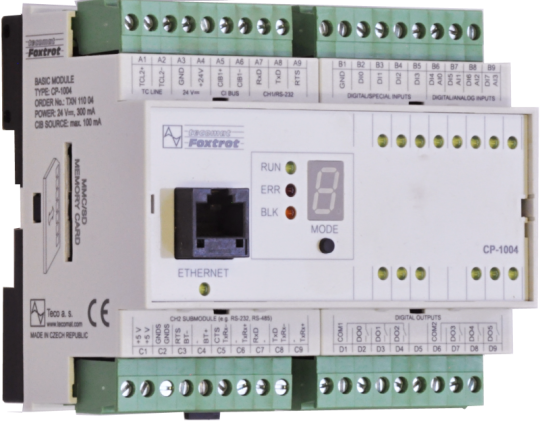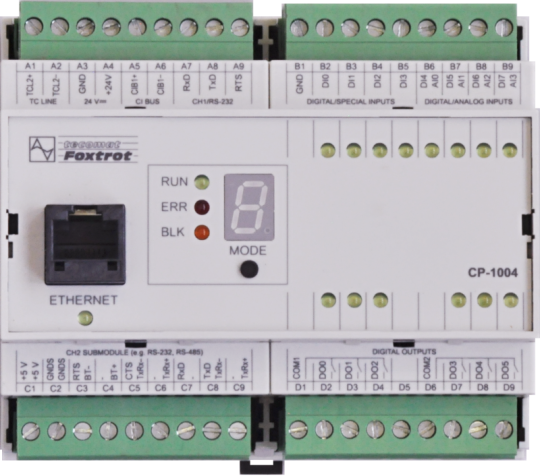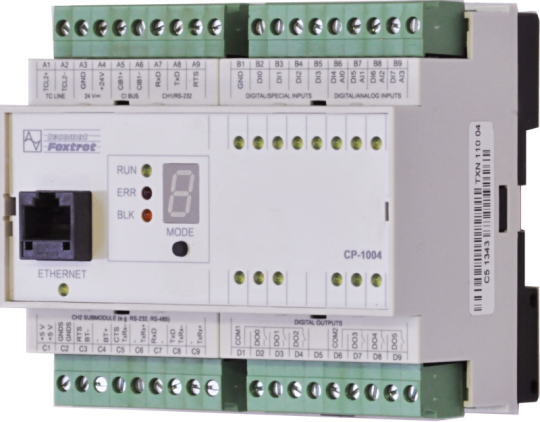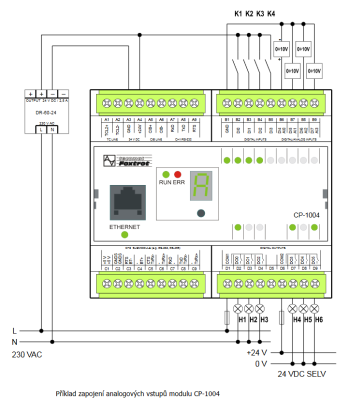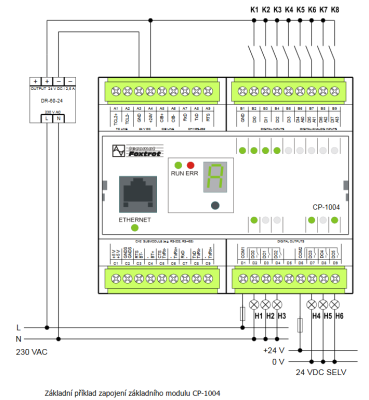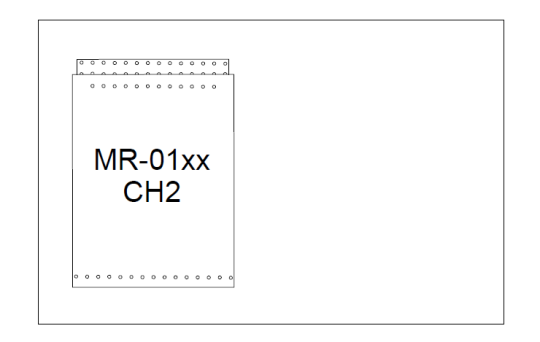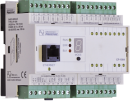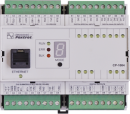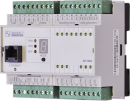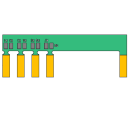CP-1014TXN 110 14
CP-1014, CPU+LCD4x20, ETH100/10, 1xRS232, 1xSCH, 4xDI/AI, 4xDI/HSC, 6xRO 230 V/ 3A, 1xCIB
| DI | 4x DI/HSC |
|---|---|
| DI/AI | 4x DI/AI |
| DO | 6x RO |
| AI | |
| AO | |
| COM | 1x ETH 1x RS-232 1-3x Serial Channel (1x free slot) 1x TCL2 1x CIB |
| SENSOR |
CP-1004, CPU, ETH100/10, 1xRS232, 1xSCH, 4xDI/AI, 4xDI/HSC, 6xRO 230 V/ 3A,1xCIB
| Order num. | TXN 110 14 |
|---|---|
| Teco code | TXN 110 14 |
| Categories | Foxtrot 1 - Basic modules |
| Tags | Sales and production discontinued |
| System parameters of the central unit | |
|---|---|
| Row of central unit | K |
| User program memory | 192 + 64 kB |
| Memory for user variables / including RETAIN variables | 64 kB/32 kB |
| Instruction length | 2 ÷ 10 bytes |
| Backup of program source code in PLC | Yes, in program backup memory (EEPROM) |
| On-line program change in PLC | Yes, including I / O configuration change |
| Memory for project archiving - internal | 2 MB |
| DataBox - additional internal data memory | 512 kB |
| Optional memory card slot | SD - Card Slot |
| Cycle time per 1k of logic instructions | 0,2 ms |
| Development environment | Mosaic |
| Programming languages | ST, IL, LD, FBD, SFC, CFC |
| RTC - Real time circuit | No |
| RAM and RTC backup 1) without / with backup battery | type. 500 hr / typ. 20,000 hours |
| Integrated Web server | Yes |
| Integrated Datalogger | Yes |
| Access to PLC variables via web API | Yes |
| Notice | 1) Applies to the basic module without power supply, the backup circuits are disconnected when the power supply is switched on 2) The serial interface CH1 is permanently equipped with an RS-485 interface. The serial interface type CH2 to CH4 is selectable via interchangeable submodules |
| COM - Communication - IP/Ethernet | |
| Ethernet 10/100 Mb (ETHx) | 1 |
| Available system modes on ETH and WLAN | UNI, PC, PLC, PLD |
| TCP / IP protocol | Yes |
| UDP protocol | No |
| HTTP protocol | No |
| WebSocket protocol | No |
| Protocol MODBUS/TCP | No |
| SMTP protocol | No |
| IEC 60870-5-104 protocol | No |
| REST API | No |
| COM - Serial channels | |
| max. number of optional serial channels in the basic module | 4 |
| max. number of expanding serial channels on the TCL2 bus | 6 |
| Number of internal RS-232 serial channels | 1 |
| Available system modes on CH5-10 | UNI, CSJ (CAN) |
| Modbus RTU / ASCII master protocol | No |
| Modbus protocol RTU/ASCII slave | No |
| Profibus DP master protocol (<180 kbit/s) | No |
| COM - System buses | |
| TCL2 - system I/O bus | 1x TCL2 master |
| TCL2 - Range of one branch of the system I/O bus | 10 I / O modules + 4 operator panels + 6 serial channels |
| The communication rate of the system I / O bus | 345 kbps |
| System I / O bus terminating resistor | 120 Ω |
| CIB - Common Installation Bus (R): Installation I/O bus | 1x CIB master (100 mA) |
| CIB - Address range of one branch of the installation bus | 32 CFox I/O modules |
| DI - Parameters of binary inputs DC (group A) | |
| Common wire | minus |
| Input type | Type 1 (IEC) |
| Galvanic isolation of inputs from internal/peripheral circuits | No |
| Diagnostics | indication of energized input by LED on module panel |
| Input voltage for log. 0 | 0 V DC; -5 V DC min.; +5 V DC max. |
| Input voltage for log. 1 | 24 V DC; 15 V DC min.; 30 V DC max. |
| Input current at log. 1 (typ.) | 5 mA typ. |
| Delay from log. 0 to log. 1 | 5 μs |
| Delay from log. 1 to log. 0 | 5 μs |
| The minimum width of the captured pulse | 50 μs |
| Notice | Note that GND terminals in 24 V DC and DIGITAL / SPECIAL INPUTS they are connected inside the system. It is not desirable to connect the GND terminal in the DIGITAL / SPECIAL INPUTS with negative pole power supply system also inputs because it would over the second GND terminal closed the loop and thereby potentially induced interfering signals. |
| HSC - Special functions of binary inputs / counters | |
| Unidirectional counter (UP) | 2x (DI0); (DI2) |
| Two unidirectional counters (UP / UPB) | 2x (DI0/DI2); (DI2/DI3) |
| Bidirectional counter (UP/DOWN) | 2x (DI0/DI1); (DI2/DI3) |
| Counter with direction control (CLK/DIR) | 2x (DI0/DI1); (DI2/DI3) |
| Bi-directional counter with reset and intercept (UP / DOWN / CLR / CAP) | 1x (DI0/DI1/DI2/DI3) |
| Counter with direction control with reset and latch (CLK / DIR / CLR / CAP) | 1x (DI0/DI1/DI2/DI3) |
| IRC Basic (V/G) | 2x (DI0/DI1); (DI2/DI3) |
| IRC with Zero and Capture (V / G / NI / MD) | 1x (DI0/DI1/DI2/DI3) |
| Measure the pulse length | 4x (DI0,DI1, DI2, DI3) |
| Period measurement | 4x (DI0,DI1, DI2, DI3) |
| RO - Parameters of binary relay outputs (group A) | |
| Parameters valid for the terminals | DO0-DO5 |
| Number of relay outputs | 6 |
| Number of output groups | 2 |
| Number of outputs in group | 3 |
| Diagnose | Alarm signaling on panel module |
| Switching current | 3 A max., 100 mA min. |
| Switching voltage | 250 V AC max., 5 V AC min., 30V DC max. |
| Short-term output overload - inrush | 4 A max. |
| Current through common clamp | 10 A max. |
| Contact closing time | typ. 10 ms |
| Contact opening time | typ. 4 ms |
| Limit values of switched resistive load | max. 3A at 30 V DC or 230 V AC |
| Switching inductive load limits DC13 | max. 3 A at 30 V DC |
| Switching inductive load limits AC15 | max. 3 A at 230 V AC |
| Switching frequency without load | max. 300 switching / min. |
| Switching frequency with rated load | max. 20 switching / min. |
| Mechanical life | min. 5,000,000 cycles |
| Electrical life at maximum resistive load | min. 100,000 cycles |
| Electrical life at maximum load inductive DC13 | min. 100,000 cycles |
| Electrical life at maximum load inductive AC15 | min. 100,000 cycles |
| Short-circuit protection | No |
| Treatment of inductive load | External RC element, varistor (AC), diode (DC) |
| Insulation voltage between outputs and internal circuits | 3750 V AC |
| Isolation voltage between groups of outputs to each other | 3750 V AC |
| AI - Organization of analog inputs | |
| Total number of analog inputs | 4 |
| Number of inputs per group | 4 |
| Number of analog input groups | 1 |
| Organization of analog inputs into groups | 4x (DI4/AI0-DI7/AI3) |
| Input type | With common clamp |
| Common wire | Minus |
| Galvanic separation from internal circuits | No |
| Diagnostics | overload signaling in status word |
| Converter type | Approximation |
| conversion time | 20 μs |
| Operating modes | periodic input sensing |
| AI - Analog Input Ranges (Group A) | |
| Voltage | 0 to 10 V / 2,579 mV |
| Voltage input error - repeatability under steady state conditions | 0.05% of full scale |
| Permissible continuous overload - voltage input | -20 V to +30 V |
| Open input detection | No |
| Power supply | |
| Nominal supply voltage (V) | 24 V DC |
| Supply voltage, tolerances | 24 V DC, +25%, -15%, SELV |
| Supply voltage when backing up with an external battery | 27 V DC, +10%, –15%, SELV |
| Typical power input | 5 W |
| Maximum power input | 8 W |
| Module thermal/power loss | 6 W |
| Maximum current consumption (mA) | 400 mA |
| Galvanic separation of power supply from internal circuits | No |
| Internal protection | Yes, PTC reversible fuse |
| Description of power supply | Difference between typical and maximum power input is given by possible load of CIB buses and number of switched outputs and CPU load |
| CIB branch power supply - parameters of the built-in master | 1x 100 mA/ 24 V DC |
| Size and weight | |
| Weight approx. | 200 g |
| Product dimensions (width x height x depth) | 105 x 92 x 63 mm |
| Module width in multiples of M (17.5 mm) | 6M |
| Module width | 105 mm |
| Module height | 92 mm |
| Module depth | 63 mm |
| Product dimensions (width x height x depth) | 105 x 92 x 63 mm |
| Operating conditions, product standards | |
| Product standard | ČSN EN 61131-2: 2005 (idt IEC61131-2: 2003) - Programmable control units |
| Protection class of electrical object | II, according to ČSN EN 61140: 2003 (idt IEC 61140: 2001) |
| IP rating (Ingress Protection) according to ČSN EN 60529: 1993 (idt IEC 529: 1989) | IP20 |
| Operating areas | Normal, according to ČSN 33 2000-3: 1995 (mod IEC 364-3: 1993) |
| Degree of pollution | 1, according to ČSN EN 60664-1: 2004 (mod IEC 60664-1: 1992) |
| Overvoltage category installation | II, acc. ČSN EN 60664-1:2004 (mod IEC 606641:1992) |
| Type of device | Module on DIN rail |
| Working position | Vertical |
| Type of operation (operating frequency) | Continuous |
| Ambient operating temperatures | -20 °C to + 55 °C |
| Operating relative humidity | from 10 % up to 95 % without condensation |
| Operating atmospheric pressure | min. 70 kPa (<3,000 m above sea level) |
| Storage temperatures | –25 °C to +70 °C |
| Electromagnetic compatibility, Mechanical endurance | |
| Electromagnetic compatibility / Emission | A, according to EN 55022: 1999 (mod CISPR22: 1997) |
| Emmisions - note | In premises where the use of radio and television receivers can be expected to be used a distance of 10 m from these devices may cause radio interference. In such a case, the user may be required to take appropriate action. |
| Electromagnetic compatibility / Immunity | min. as required by EN 61131-2: 2007 |
| Sinusoidal vibration endurance | 10 Hz to 57 Hz, amplitude 0,075 mm, 57 Hz to 150 Hz, acceleration 1 G (Fc test according to EN 60068-2-6: 1997 (idt IEC 68-2-6: 1995), 10 cycles per axis.) |
| Packaginng, transportation, storage | |
| Description |
The module is packed in a paper box according to the internal packing instructions. This documentation is also part of the package. The outer packaging is carried out according to the scope of the order and the method of transport in a transport package provided with transport labels and other data necessary for transport. Transport from the manufacturer is carried out in the manner agreed upon when ordering. The transport of the product by the customer's own means must be carried out by covered means of transport, in the position specified by the label on the packaging. The box must be stored in such a way that it does not move spontaneously and the outer packaging is not damaged. The product must not be exposed to direct weather conditions during transport and storage. Transport is permitted at temperatures of -25 ° C to +70 ° C, relative humidity of 10% to 95% (non-condensing) and a minimum atmospheric pressure higher than 70 kPa. The product may only be stored in clean rooms free of conductive dust, aggressive gases and vapors. The most suitable storage temperature is 20 ° C. |
| Installation | |
| Assembly description | Switchboard mounting |
| Assembly description | The basic module is mounted vertically on the U-rail ČSN EN 50022. Installation of the assembly (basic module and peripheral modules, if any) is carried out according to TXV 004 10. |
| Exchangeable submodules | The optional MR-01xx submodules with serial channel 2 interface are mounted on the center plate in the CP-10x0 basic module to the position indicated in Fig. 7.1. To add or replace a submodule with a serial channel interface, release the latches on |
| Exchangeable submodules | The optional MR-01xx serial interface submodules are fitted to the CP-1004 basic module on the center plate to the position indicated in Fig. 7.1. If necessary, the installation or replacement of a submodule with a serial channel interface is required Use a screwdriver to release the latches on the bottom of the housing. After removing the lower part of the case, remove it the board assembly from the rest of the housing (by gently pressing the inner board assembly downward on the Slide the Ethernet connector down). After removing the top plate with indication and connector The Ethernet interface is a replaceable submodule accessible. After installing the submodule boards carefully insert into each other - be careful not to bend the tips and the following incorrect insertion. Then assembled Carefully slide the plate assembly into the cover. Pay attention to the risk of bending the LEDs and correct alignment button and ETHERNET connector. After insertion into the cover snap the bottom of the module. |
| Module operation | |
| Module configuration | The module is operated, set up and diagnosed from the Mosaic development environment. |
| Commissioning | The module is ready for operation after connection of the supply voltage. The module panel is available MODE button to display the currently set Ethernet IP address. Parameters of all interfaces are set in the Mosaic programming environment. The exact setting procedure is shown in TXV 004 documentation 10. Other activities (programming, application debugging, etc.) are performed in the MOSAIC development environment. |
| Module diagnostics | The basic diagnostic system of the module is a part of its standard software. It operates from module power on and operates independently of the user. Diagnostic error the status of the module and the connected peripheral modules of the assembly are indicated on the module display and are available for processing by the master system. For more information see TXV 004 10. |
| Maintenance | |
| Description | The module does not require any maintenance under general installation conditions. The operations in which a part of the module has to be dismantled must always be carried out with the supply voltage disconnected. |
| Warning | Since the module contains semiconductor components, it is necessary to observe the rules for working with electrostatically sensitive components when handling the removed cover. It is not allowed to touch the printed circuits directly without protective measures. |
| Additional backup battery - maintenance |
|
| Warranty | |
| Warning |
|
HW documentation
CP-1004 Basic documentation
688.62 kB, (CS, EN)
User manuals
Foxtrot1 - User's Guide, cze, , TXV00410_01
3.40 MB
Foxtrot1 - User Manual (en), TXV00410_02
4.30 MB
Files for designers
CP-1004 Technical drawing DWG
137.71 kB
CP-1004 Technical drawing DXF
390.68 kB
- CP-1014 - The CP-1014 I/O layout (inputs, outputs, power supply, communication interface) is identical with the CP-1004. The front panel is different: instead of indication LEDs and a small seven-segment indicator there is a larger display with 4x20 cha...
- CP-1004 - The CP-1004 basic module is the smallest independent control system in the Foxtrot series. A standard configuration of the module is in a 6M housing on a DIN rail (for the housing dimensions, see Chapter 6M housing on a DIN rail ), and it is fitte...
- Backup power supply CP-1004, the PS2-60/27 source - Fig. 1 An example of a backup power supply of the CP-1004 basic module Notes: The power supply must be stabilized 27.2 VDC, complying with SELV requirements, and it must be designated for charging the connected ba...
- Special functions of the CP-1004 module binary inputs - The DI0, DI1 (counter 1) and the DI2, DI3 (counter 2) binary inputs can be set - in addition to the function of standard inputs - to one of the special functions, allowing the connection of a positioning incremental encoder, application of fast cou...
- Foxtrot basic module power supply - ...Max. power consumption 1) Typical power consumption 2) CP-1004, CP-1014 8 W 4 W CP-1005, CP-1015...
- Power dissipation of modules for calculation of switchboard heating - ...SCH, 8xAI/DI, 8DI/HSC, 4xAO, 8xRO, 4xDO, 2xTCL2 CP-1003 10,0 W TXN 110 04 CP-1004, CPU, ETH100/10, 1xRS232, 1xSCH, 4xDI/AI, 4xDI/HSC, 6xRO 230 V/ 3A,1xCIB CP-1004 5,0 W...
- Internal CIB master at the CP-10xx - ...CP-1003 It has no CIB master It has no CIB master CP-1004, CP-1014 100 mA 1 A (module C-BS-0001M )...
- First generation Tecomat Foxtrot PLC - ..., Provedení: DIN-RAIL, Interface: Multi, Bus: TC700, Input: true, Output: true, Analog: true, Binary: true ] CP-1004 CP-1004-Základní modul Foxtrot [ DI: 8, DO: 6, Typ: PLC-Foxtrot, Výrobce: Teco, Provedení: DIN-RAIL, Interfa...
- IB-1301, a module of 24V binary inputs - ...). The DI0 ÷ DI3 inputs allow the implementation of special functions identical with the inputs of the CP-1004 basic module (the functions and input modes are identical with the DI0 ÷ DI3 inputs of the CP-1004 module). Fo...
- IR-1501, the module of relay outputs - .... The DI0 ÷ DI3 inputs allow the implementation of special functions identical with the inputs of the CP-1004 basic module (the functions and input modes are identical with the DI0 ÷ DI3 inputs of the CP-1004 module). Fo...
- The analogue inputs, metering the current 0 ÷ 20 mA - ...to an external power supply of current loops (see Fig.1). Fig. 1 An example of the MT-1690 shunt connection to the CP-1004 (current analogue inputs). ...
- CF-1141 external CIB master - .... 1. Connecting the CF-1141 to the Foxtrot basic module A complete example of the CF-1141 connection to the CP-1004 is presented in Chapter 3.3.4 . A backup battery can also be connected to the CF-1141 module, as...
- Decoupling power supply to CIB – the C-BS-0001M decoupling module - ...o boost the CIB power circuitry of the basic modules fitted with a CIB power supply circuit only with a limited output (e.g. CP-1004, CP-1006), or for older versions of the Foxtrot basic modules, which had no CIB supply circuits installed. Maximum...
- FOXTROT – the basic and peripheral modules, power supply - ...a simplified input and output tables: The front view of the basic module (an example - the CP-1004): The CP-1004 represents the simplest variant of the Foxtrot basic module. The basi...
- Connecting a slave device with an M-bus interface, the SX-1181 module - ...e powered from a separate power supply. Fig. 1. Connecting the SX-1181 module to the CH1 interface of the CP-1004 module Notes: Up to 64 meters can be connected to the SX-1181 module, which implies a maxi...
- SMS communication, connecting the INSYS GSM small modem to the Foxtrot basic module - ...e of the Foxtrot basic module. Fig. 1. An example of connecting the SMS modem INSYS to the Foxtrot basic module CP-1004 Notes: The conditions for connecting the RS232 interface are the same as those in the...
- SMS communication, connecting the UC-1205 modem to the Foxtrot basic module - ...tor for antenna connection. Fig. 1. An example of connecting the SMS modem UC-1205 to the Foxtrot basic module CP-1004 Notes: The UC-1205 SMS modem is in terms of communication a standard modem device, so the...
- MR-0105, MR-0106, MR-0115, fitted with the CP-10x4, CP-10x5 - Tab. 1: Terminating of the CH2, CH3 and CH4 communication channels for the CP-10x4 , CP-10x5 Terminal block C Terminal MR-0105...
- The FOXTROT basic modules - The CP-10xx analogue inputs, ranges, basic information The analogue inputs in basic modules make it possible to connect a number of sensors and measured signals. Each CP-10xx variant is fitted with various numbers of inputs with different para...
- Connecting an electricity meter via the TXN 149 01 optical head - The TXN 149 01 optical interface probe (also called an optical head) is designed to read data and to communicate with the electricity meter, the ripple control receiver and other devices. The probe converts optical signals into signals of the serial...
- cyclically rebooted - Tecomat Foxtrot CP-1004 when transmitting data via ethernet, the controller is cyclically overloaded, after disconnecting the LAN cable, the controller works normally.
 English
English
